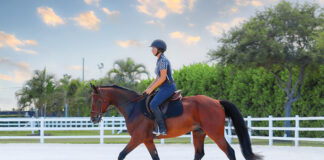
If you’ve studied dressage in the past, you may have learned the training scale, a six-level pyramid of increasingly advanced concepts. The first three levels are the building blocks to connection, or getting your horse on the bit.
“Part of being in a working gait—where your horse most easily balances himself—is a regular rhythm and a comfortable tempo; not too fast and not too slow,” says dressage clinician and author Jane Savoie.
SUPPLENESS: Once a horse has developed a steady rhythm, the next goal in training is suppleness. “This refers to your horse’s ability to smoothly change his balance forward and back and side to side,” says Savoie. “This requires both lateral suppleness through his side and longitudinal suppleness over his topline.” Your horse’s muscles need to be loose and elastic through the poll, neck, shoulders, back and hips to accomplish this (See “Keys to Suppleness” for more on this).
CONTACT/CONNECTION: “You should have ‘inviting’ or ‘sympathetic’ contact before you try to put your horse on the bit,” says Savoie. “When you give the connecting aids to put your horse on the bit, you’re asking him to go forward into your hand, so your hand must be inviting and sympathetic.”
Back to Dressage Mysteries Solved >>
This article originally appeared in the January 2010 issue of Horse Illustrated. Click here to subscribe.







Thanks for the good article.
Always nice to read another trainer’s ideas and technical steps towards collection.